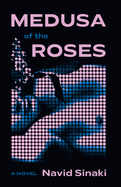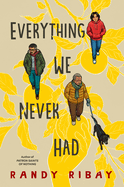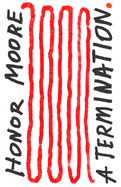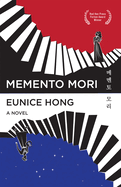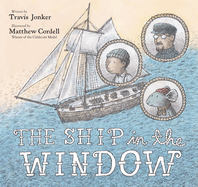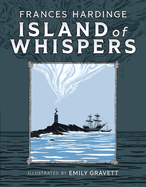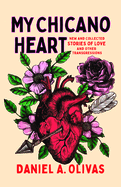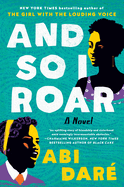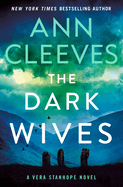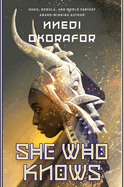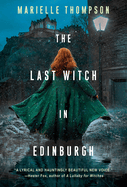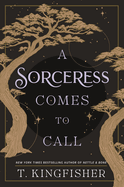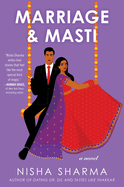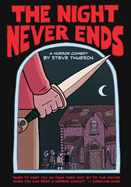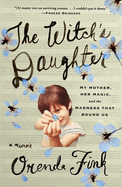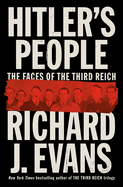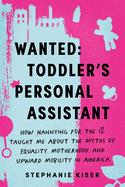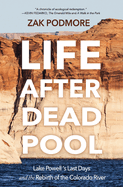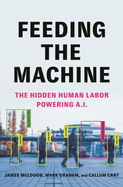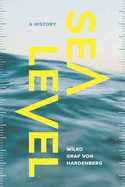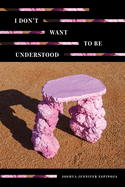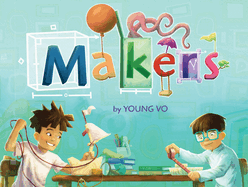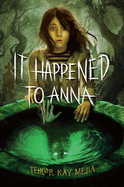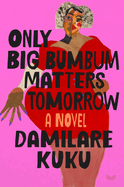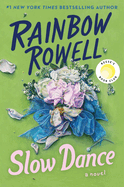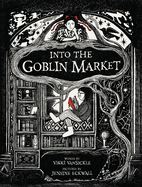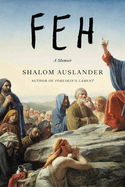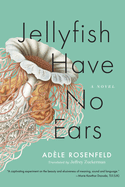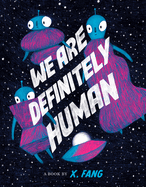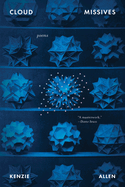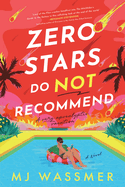Friday, August 30, 2024
We're pleased to say that the books reviewed in this week's issue are likely to leave a mark, especially Bill Schutt's fresh survey of the animal kingdom, Bite: An Incisive History of Teeth, from Hagfish to Humans, which is positively a "treasure trove of... facts" about the eating habits of vampire bats, which frogs have teeth, and more. Meanwhile, Navid Sinaki writes about desire "with a blade's edge" in his debut novel, Medusa of the Roses, a "spellbinding story [that] unfolds not as a myth retold but as a fresh legend." Plus, with Everything We Never Had, acclaimed author Randy Ribay delivers a "profound multigenerational" saga of Filipino American men, enriched by real historical events, as he "intimately explores how to balance familial expectations with an evolving sense of self."
In The Writer's Life, novelist Caro De Robertis shares the story of discovering a kindred spirit in Jo March and the impact of reading Milan Kundera's The Unbearable Lightness of Being. Plus, they ruminate on the value that can be found in the practice of rereading.
Medusa of the Roses
by Navid Sinaki
Invoking classic myths, Navid Sinaki's sweetly sinister debut novel, Medusa of the Roses, conjures a pair of ill-fated lovers as timeless as Pyramus and Thisbe. Anjir and Zal live in Tehran, where their childhood friendship has flourished into a clandestine affair despite Zal's marriage to a woman named Mahtob. For his part, Anjir identifies with Tiresias, "the man from Greek mythology who turned into a woman simply by striking two snakes." The government in their country "[c]ould kill you for being gay, but will foot the bill if you agree to a sex change." Although they conspire for a future elsewhere, one in which Mahtob is out of the picture, Zal is attacked after visiting an underground gay club, leaving him hospitalized. Shortly afterward he disappears.
Sinaki writes Anjir's desire with a blade's edge, his longing for Zal complicated by the many betrayals between them, the utmost being that Zal was with another man when he was attacked. Yet as Anjir's menacing passion drives the noirish stakes from one murder plot to the next in his search for Zal, he discovers a pivotal friendship in Leyli, a wealthy trans woman considering government subsidies for surgery. "We meet somewhere in between our desires to be unbothered. Her as a woman, me as a lover...." From her he lifts pearls, hormone pills, and affectations necessary for "the role of [Zal's] new wife."
In Medusa of the Roses, every observation comes decorated with mordant humor ("Let's hope like Joan Crawford I die a bitch"). Its spellbinding story unfolds not as a myth retold but as a fresh legend for modern times. --Dave Wheeler, senior editor, Shelf Awareness
Discover: This sweetly sinister novel of ill-fated lovers draws on classic myths to conjure a fresh legend for modern times.
Memento Mori
by Eunice Hong
Eunice Hong's exquisite debut Memento Mori won the 2021 Red Hen Press Fiction Award, chosen by judge Aimee Liu. Hong's simple, well-worn opening line, "Once upon a time," belies an intricate narrative that combines ancient storytelling, epistolary revelations, historical family saga, and contemporary bildungsroman.
"I write to remember. I write to forget," a young Korean American woman insists. She's been telling her younger brother, M., stories for years. Now, on M.'s behalf, she's recording these stories about their paternal grandmother, who escaped North Korea at the cost of separation from her family; about their maternal grandmother, who once sewed for and dressed Beyoncé; and about their parents, who moved from Seoul to New Jersey and back to Seoul. She also struggles to reveal what "was a bit too awkward to say out loud to you, my little brother," an understatement that initially obscures horrific violence and attempted suicide. Somehow she survives to bear witness to loss--and living.
Hong is an elliptical writer with impeccable timing, infusing her sparse prose with layered insights about grief, empathy, resilience, and, most intriguingly, the power of choice. When the aching intimacy threatens to become unbearable, Hong cleverly dovetails familiar Greek myths--Persephone and Hades, Eurydice and Orpheus--"stories about the underworld and the afterlife to try to understand" sexual assault, wrongful death, and desperate reconciliations. At the novel's end, final notes explicate Hong's chapter titles, such as " '15. Leaving Elba," "Bed 31," and "73rd and Broadway," which brilliantly, delightfully contain both numerical order and narrative clues. Hong's debut proves utterly remarkable. --Terry Hong
Discover: Eunice Hong's exquisite debut, Memento Mori, centers a young Korean American woman's intricate, intimate examination of loss and survival, tragedy and resilience.
My Chicano Heart: New and Collected Stories of Love and Other Transgressions
by Daniel A. Olivas
Daniel A. Olivas (The King of Lighting Fixtures) writes with a comforting charm, although that doesn't imply all his stories are charming--assault, injustice, dysfunctions, death are included here, along with joy, beauty, and new discoveries. Love, Olivas shares in his introduction to My Chicano Heart, "in its many forms: romantic, familial, platonic, and even narcissistic," runs through these 31 stories.
Among the diverse, impressive plethora, Olivas's slice-of-life narratives prove particularly notable. A recently retired executive endures her husband's not-so-innocent quips in "Quack," but clearly savors her own revenge. In "Los Dos Fridas," a California divorcé (who unsuccessfully demanded his ex-wife choose between her writing or their marriage) finds solace with the titular Frida Kahlo painting in Mexico City's modern art museum. A small town's self-anointed "most sophisticated resident"--a formerly lauded writer--agrees to help a stranger translate his late wife's memoir in "The Jew of Dos Cuentos." In "The Fairy Tale of the Man and the Woman," two neighbors share regular dinners for over 20 years, until the woman decides to stop opening her door. In "La Diabla at the Farm," even the devil needs the occasional vacation--to go hunting at Stanford University.
My Chicano Heart is Olivas's second collection, after How to Date a Flying Mexican, published in the University of Nevada Press's "The New Oeste" series. Imaginative Olivas deftly jumps between realism, magical surrealism, the mysterious and fantastical, capturing indelible glimpses of longing and loss, cleaving betrayal and healing renewal. --Terry Hong
Discover: Daniel A. Olivas's wide-ranging, impressively versatile collection My Chicano Heart presents 31 intriguing stories written over the last quarter century.
The Berlin Apartment
by Bryn Turnbull
Bryn Turnbull's riveting fourth novel, The Berlin Apartment, examines the difficulties and dynamics of life on both sides of the Berlin Wall. Through the story of Uli and Lise, a young couple separated by the wall's construction, Turnbull (The Paris Deception) vividly highlights the restrictions faced by East German residents, and the freedoms--and frustrations--of their loved ones in West Berlin.
In 1961, Uli has just proposed to Lise when, overnight, the wall leaves them stranded on opposite sides of Berlin. Uli and his fellow engineering students soon begin digging an escape tunnel to the East, hoping to smuggle Lise and other loved ones to the West. The risks they take, plus Lise's small acts of rebellion, ratchet up the narrative tension, leaving readers wondering who will make it across the border--and at what cost.
Turnbull delves into the details of the era, exploring East German fashion through Lise's job working for a seamstress and the complicated clash of family and Socialist Unity Party loyalties via Lise's brother, an ambitious officer in the Volkspolizei, the East German national police force. Uli is afforded more freedoms in his daily life in West Berlin, but Turnbull depicts how the long shadow of Communism darkened lives in both German republics. Uli and Lise face impossible choices, but they cling to hope and optimism, even as their lives unfold far differently than they had planned.
Taut, thoughtful, and tender, The Berlin Apartment captures the lasting effects of division and distrust--but also pays tribute to grit, innovation, and the strength of true love. --Katie Noah Gibson, blogger at Cakes, Tea and Dreams
Discover: Bryn Turnbull's riveting fourth novel explores life on both sides of the Berlin Wall through the story of a pair of young lovers determined to make their way back to each other.
And So I Roar
by Abi Daré
Abi Daré's sensational debut novel, The Girl with the Louding Voice--a Jenna's Book Club choice--was the story of heroine Adunni's introduction to chaotic, sense-bombarding Lagos. Now, And So I Roar recounts her mentor Tia's wake-up call to life in Adunni's native village of Ikati, a place with no running water, little food, and traditions tied to ending drought. While readers need not have read Daré's first book, their experience will be the richer for it, as Daré builds out a stunning contrast between the urban and rural areas of Nigeria in 2015.
This gripping second novel starts in Lagos right where the first one ended, and alternates between Tia's and Adunni's points of view. Smart, strong, and with an unwavering sense of justice, 14-year-old Adunni is excited about attending school in Lagos on a scholarship. Adunni has left Big Madam's home, where she had been human trafficked and forced to work as the woman's housemaid after fleeing a marriage she'd been sold into by her father in Ikati. Tia, a lawyer married to a physician, played a key role in getting Adunni out of that situation. But Tia has no idea what she's gotten into.
As different as her characters initially seem--Tia is wealthy and has every advantage, while Adunni comes from nothing and appreciates every kindness that comes her way--Daré does an exceptional job of demonstrating their similarities and the universal need for love and growth as human beings. The plot twists and turns, taking readers back to Ikati with Adunni and Tia, and exposing both betrayals from intimates and generosities from strangers. Readers will hope for more from this accomplished author. --Jennifer M. Brown, reviewer
Discover: In her second gripping novel, Abi Daré exposes the similarities between two women from seemingly polar ends of Nigerian culture and society in 2015.
Mystery & Thriller
The Dark Wives
by Ann Cleeves
Northumbria Police Detective Inspector Vera Stanhope, the bighearted battle-ax anchoring Ann Cleeves's much-loved Vera Stanhope books, returns in The Dark Wives, the series' satisfying-on-all-levels 11th title. The novel finds the detective racked with guilt following the on-the-job death of a subordinate colleague and seriously considering something radical for her: self-improvement.
Answering a 999 call, Vera arrives at Rosebank, which Chloe Spence, one of its young residents, describes in her diary as a home "for the teenage kids nobody wants." A dog walker has found the hammer-bludgeoned body of Josh Woodburn, a temporary Rosebank worker, on the common near the home. As for Chloe, she hasn't been seen since Josh died. This would seem to make her the prime suspect--surely the timing of her disappearance isn't coincidental--but Vera resists drawing this conclusion because of what she reads in Chloe's left-behind diary.
Cleeves (The Rising Tide) has mastered the prolonged suspenseful ending, this one playing out at the Witch Hunt, an annual village tradition that the frivolity-averse Vera thinks of as "a kind of glorified game of hide-and-seek." Detective Sergeant Joe Ashworth, who knows his "control freak" boss better than anyone, finds his competitive muscles flexed by a conspicuously ambitious (that's a Vera no-no) new detective constable. Joe wonders how long the newbie will last on their team; as for how long the getting-on-in-years Vera will, her resolve to do better--"She'd decided, hadn't she, to be more communicative with the team, more collaborative?"--gives readers hope that she won't be retiring anytime soon. --Nell Beram, author and freelance writer
Discover: The satisfying-on-all-levels 11th book in the Vera Stanhope series finds the Northumbria Police detective inspector looking for the killer of a children's-home worker.
Science Fiction & Fantasy
She Who Knows
by Nnedi Okorafor
In the exciting coming-of-age novella She Who Knows by Nnedi Okorafor (Binti: Home), young Najeeba refuses to follow the rules laid down for women in her desert community. The Osu-nu people are considered untouchables, and they survive by sending members on a yearly pilgrimage to a dead lake, where they gather salt to sell in the markets. Women are not allowed, but when Najeeba receives the call to go, she becomes a catalyst for change.
Najeeba is charmingly impulsive, making seemingly rash decisions that drive the otherwise quiet plot. She hides her face under a veil and forcibly takes the lead on selling her family's salt at the market, although their society forbids women from being there. She's empowered by her success, but her family is horrified; this strains the strong bond she once had with them. As the conflict grows between her desire for greater freedom and her family's aversion to violating the gender norms they have always followed, the stakes of her actions mount ever higher.
Okorafor builds her postapocalyptic world from an assemblage of technology, magic, and folklore, and gradually reveals tantalizing pieces of its history and how it came to be. The dead lake makes for a particularly striking backdrop--a lifeless but strangely beautiful expanse of salt. Okorafor's vivid and appealing descriptions of food, like the "large pan of sizzling chopped tomatoes, olive oil, smoke aku, sauteed onions, curry, smoked mushrooms, and chili peppers" establish a fully realized setting. Propelled by the magical experiences that draw Najeeba toward her destiny, She Who Knows is a satisfying adventure for lovers of fantasy and female rebellion. --Carol Caley, writer
Discover: She Who Knows is an exciting story of female defiance set in a post-apocalyptic world melding fantasy and sci-fi.
The Last Witch in Edinburgh
by Marielle Thompson
Edinburgh in 1824 is not a safe place to be a woman, especially one as young and beautiful as Nellie Duncan. But she finds solace and community in an apothecary full of witches. The Last Witch in Edinburgh by Marielle Thompson (Where Ivy Dares to Grow) is full of characters who feel like friends and explores feminism and the patriarchy over two centuries.
Although Nellie finds support in the apothecary--and a romance with the fiery Jean--it cannot protect her from the growing fervor of a witch hunt. When the story jumps forward to the modern world, Nellie might no longer be facing literal gallows, but the challenges of being a woman continue to plague her even though she's aided by the supernatural. Thompson incorporates fascinating folklore elements as she reexamines the Scottish myth of the Cailleach, a hag goddess, and considers how stories can be retold to serve new ideologies.
The dual settings of Edinburgh in 1824 and the modern day come to life. Nineteenth-century Scotland is often rendered nostalgically in fiction, and although Thompson skillfully evokes its whiskey, stonework, and mud, she avoids the trap of romanticization. Instead, she thoughtfully portrays the harsh realities of gripping dread and constant threats that women in such a deeply patriarchal time would have faced. She paints an unflinching yet loving portrait of a city that feels both ancient and timeless.
Nellie is a compelling character who is flawed and relatable in her struggle to fight the powerful forces she's so afraid of. Thompson delivers a delightful and well-considered read for fans of sapphic romance, strong feminist themes, and witchy women. --Carol Caley, writer
Discover: A young woman finds solace and community in an apothecary full of witches in 1824 Edinburgh in this cozy page-turner that explores feminism and the patriarchy over two centuries.
A Sorceress Comes to Call
by T. Kingfisher
Inspired by the Brothers Grimm's "The Goose Girl," A Sorceress Comes to Call by Hugo Award-winning author T. Kingfisher is a heart-wrenching story about two women fighting to hold their own space in a world determined to overshadow them. Fourteen-year-old Cordelia spends her days cooking, cleaning, and riding her horse, Falada. When other people look at Cordelia, they see an exceptional young lady but, as in most fairy tales, all is not as it seems. Cordelia's mother, Evangeline, has the ability to possess her--completely. Cordelia calls it "being made obedient," but she believes it is the normal plight of being a sorceress's daughter.
Elsewhere, Hester wakes with the sense that doom is creeping toward her doorstep. At 51, Hester is content to be a spinster and to live in her ancestral home with her brother, Squire Samuel Chatham. Her peaceful life is upended when Samuel brings home a beautiful woman with her timid teenage daughter in tow. As soon as Evangeline crosses their threshold, Hester knows her nightmare was an omen.
An unlikely friendship forms between Cordelia and Hester as they attempt to rescue Samuel (and themselves) from Evangeline's clutches. The third-person narration alternates between Cordelia and Hester with no clear delineation, but the characters' voices are so distinct that the transitions work seamlessly. The atmosphere teems with quietly sinister magic. Even in her darkest works, Kingfisher writes warmth and humor into her characters, and readers will find delightful sparks of comic relief sprinkled throughout this novel. Kingfisher has once again proven to be a master of melancholy low fantasy. --LeeAnna Callon, manager/bookseller/fishwife at Blue Cypress Books, New Orleans, La.
Discover: Hugo Award-winning author T. Kingfisher weaves a dark, spellbinding reimagining of "The Goose Girl" in A Sorceress Comes to Call.
Romance
Marriage & Masti
by Nisha Sharma
Marriage & Masti is the third and final title in Nisha Sharma's If Shakespeare Were an Auntie series. It tells the story of Veera and Deepak, best friends and successful businesspeople. The two have been apart for several months, but after a series of dramatic events, Veera and Deepak reunite at a romantic resort in Goa, India, have a few too many drinks, and stage a fake wedding that Deepak realizes feels very real. While they agree to temporarily use the fake marriage to further their own business ends, once they recognize how thrilled their families are with the match, their whole plan is thrown into question.
On the romance novel realism scale, Marriage & Masti rates much closer to bonkers than realistic, but the unrealistic events are charming and feel rational within the world of the story. Unlike many individual volumes in romance series, Marriage & Masti could be difficult to read on its own, since Sharma (Dating Dr. Dil) established the central dramatic plotline in earlier novels. Many characters from the series' first two books return here, too, including the mischievous Mrs. W.S. Gupta, the dating advice and gossip columnist, and, of course, the aunties who swoop in to teach Veera how to be a proper Hindu wife.
The novel skillfully and entertainingly deploys such tropes as friends to lovers, a fake marriage that's also a marriage of convenience, rich and powerful main characters (both Veera and Deepak have black American Express cards), and the male lead falling in love first. Marriage & Masti is an excellent, sexy contemporary romance that will not disappoint lovers of the genre. --Alyssa Parssinen, freelance reviewer and former bookseller
Graphic Books
The Night Never Ends
by Steve Thueson
Of course, birthdays should be memorable, especially the night before the big 3-0! Cartoonist Steve Thueson makes sure of that in The Night Never Ends. "Okay, gather round, children!" Kate demands of her four friends. "For the last night of my twenties, I wanted to do something good and special." Armed with a Ouija board (Em found it "hanging out in [her] mom's closet"), the quintet break into an abandoned house (multiple attempts are required), tracking the truth behind tall tales of murderous fathers, deadly fires, and suicide pacts. Once inside, their fun begins with rude graffiti as they trek to "the spookiest room in the house," where they prepare for their Ouija hocus-pocus, although some of them would prefer to go to a secret concert just posted on social media. Horrifying screams draw them to the basement. Who's gonna survive this never-ending night?
Break-ins. Murders. Sacrifice. Terrible stuff. Except Thueson certainly enjoys the morbid fun, even suggesting they might be that first victim, who happens to match their illustrated author picture, down to the identical T-shirt. Tempering the guffaws, however, are occasional sobering reality checks that spotlight white privilege, police violence, and gun control. Thueson's tightly ordered panels, which cleverly contrast with their chaotic contents, are awash in full color and saturated in a palette of darker browns, grays, deep plums, and bloody reds. Despite the gore, comic relief comes often, including a "Big Gulp" cup as the holy vessel for catching the crimson bounty from the incantations of "sanguis bibimus." But the sun will come up... maybe! --Terry Hong
Discover: Cartoonist Steve Thueson knows just how to provide guffaw-inducingly horrific comic relief in The Night Never Ends.
Biography & Memoir
A Termination
by Honor Moore
Poet and memoirist Honor Moore's A Termination is a fascinatingly discursive memoir that circles her 1969 abortion and contrasts societal mores across her lifetime.
During the spring in question, Moore (Our Revolution) was a 23-year-old drama school student. Her lover, L, was her professor. But she also had unwanted sex with a photographer. She did not know which man had impregnated her, but she did know she didn't feel prepared to become a mother. She convinced a psychiatrist that doing so would destroy her mental health, and he referred her to an obstetrician for a hospital procedure. The termination was "my first autonomous decision," Moore insists, a way of saying, "I want this life, not that life."
Family and social factors put Moore's experiences into perspective. The first doctor she saw refused Moore's contraception request because she was unmarried. Her mother, however, bore nine children and declined to abort a pregnancy when advised to do so for medical reasons. Moore observes she made her own decision almost 10 years before "the word choice replaced pro abortion."
This concise work is composed of crystalline fragments. The stream of consciousness moves back and forth in time, incorporating occasional second- and third-person narration as well as highbrow art and literature references. Moore writes one scene as if it's in a play and imagines alternative scenarios in which she has a son; though she is curious, she is not remorseful. The granular attention to women's lives recalls Annie Ernaux, while the kaleidoscopic yet fluid approach is reminiscent of Sigrid Nunez's work. It's a stunning rendering of steps on her childfree path. --Rebecca Foster, freelance reviewer, proofreader and blogger at Bookish Beck
Discover: Honor Moore's fascinating memoir, a concise work composed of crystalline fragments, circles her 1969 abortion and contrasts societal mores across her lifetime.
The Witch's Daughter: My Mother, Her Magic, and the Madness that Bound Us
by Orenda Fink
Orenda Fink, best known as half of the musical duo Azure Ray, opens her devastating first memoir by describing a screaming fight with her mother that took place over Zoom. In 2019, Fink and her husband, fellow musician Todd Fink, bought a house in Twentynine Palms, Calif., on the edge of the Mojave Desert. It was there, nearly 2,000 miles away from her mother, that Fink began to come to terms with an unsettling reality: her mother "fit the criteria" for borderline personality disorder. For as long as Fink could remember, her mother had insisted that she was different, that they were different, possessing an innate magic. The ineffable nature of magic became a theme that followed Fink through her Alabama childhood and her acclaimed indie rock career. But was this magic real or was it a manifestation of her mother's mental illness?
The Witch's Daughter is as enthralling as it is brutal, and readers won't be able to tear their eyes away from it. Fink employs the same lyrical delicacy as she does in her songwriting to write candidly about the trauma inflicted on her family by her mother's illness. With each recollection of Fink's mother's mania and cruelty, the woman grows into an almost mythical figure: she's no longer just a witch, she's the bogeyman. Fink's story is, at its core, about the healing power of music, and it's dotted with cameos from some of indie rock's most beloved musicians. Fans of Jennette McCurdy's I'm Glad My Mom Died and Michelle Zauner's Crying in H Mart will find The Witch's Daughter haunting. --LeeAnna Callon, manager/bookseller/fishwife at Blue Cypress Books, New Orleans, La.
Discover: Indie rock darling Orenda Fink bares her soul in this devastating memoir about growing up with a mother deep in the throes of mental illness.
Hitler's People: The Faces of the Third Reich
by Richard J. Evans
Insightful biographical essays on Nazis of all ranks provide a detailed picture in Richard J. Evans's Hitler's People: The Faces of the Third Reich, an attempt to answer the question of how members of the Nazi Party were able to take over German institutions.
Whether the leaders of the Nazi movement were deranged individuals or ordinary people is an increasingly relevant question around the world, since, as Evans notes, "Strongmen and would-be dictators are emerging, often with strong popular support, to undermine democracy, muzzle the media, control the judiciary, stifle opposition, and undermine basic human rights." Drawing on new biographies of Nazi leaders and on previously unavailable materials, Evans, former Regius Professor of History at the University of Cambridge, strikes a reasoned balance between the need to understand societal context and building a convincing case for the importance of individual personalities.
An opening chapter on Adolf Hitler, coming in at almost 100 pages, also provides an overview of the major historical events discussed throughout the book. Although the 22 chapters are self-contained, Evans (The Third Reich Trilogy) arranges them so they flow easily with little repetition; readers who proceed through all the chapters consecutively will not feel bogged down. The book's final section, "The Instruments," focuses on figures further from the center of the party's power. This section is especially intriguing when it examines women who attracted notoriety because of "the perception that by taking part in the crimes of the Third Reich, [they] were violating gender norms and behavioural expectations in the most radical possible way." This is a valuable work for readers interested in history or threats to democracy. --Kristen Allen-Vogel, information services librarian at Dayton Metro Library
Discover: Biographical essays on Nazis of all ranks combine for a thoughtful analysis of how individuals and societies coalesce to commit atrocities.
Wanted: Toddler's Personal Assistant: How Nannying for the 1% Taught Me About the Myths of Equality, Motherhood, and Upward Mobility in America
by Stephanie Kiser
Stephanie Kiser's debut memoir, Wanted: Toddler's Personal Assistant, chronicles her experience as a nanny for the wealthy, wanting, and whining. Kiser skillfully contrasts stories from her own childhood, which was closer to poverty than Park Avenue, with her work as a nanny for overprivileged children in New York City. A first-generation college student, Kiser graduated with a degree, a dream of writing TV shows, and student loan debt higher than "the total of two brand new BMWs," but when she was unable to make ends meet on an entry-level salary, she was forced to change plans: "Being a nanny was the last job I wanted, but necessity outweighed pride, and so here I am."
Kiser's amusing anecdotes about the quickly outgrown designer clothes, refined palates, and extravagant birthday parties of the children she works for enhance her commentary on the intersections of economic status and child care. Among her poignant observations of parents who give their children too much or too little, Kiser pinpoints how struggles with gender inequality and mental health resonate within all households, regardless of income. Privy to differing economic situations, Kiser also celebrates the unmatched strength of hardworking mothers and nannies.
The journey Kiser presents in Wanted demonstrates the impact of perseverance and healthy boundaries. As she helps toddlers through their growing pains, Kiser also works through growing pains of her own, including job uncertainty, college debt, and the search for her place in the world. Kiser's lively sense of humor allows her to use those growing pains to find her way through adulthood. Wanted is a powerful portrait of one woman's personal and professional success. --Clara Newton, freelance reviewer
Discover: This amusing, poignant memoir describes the challenges and rewards of nannying for wealthy families as its author experiences personal growth.
Political Science
Life After Dead Pool: Lake Powell's Last Days and the Rebirth of the Colorado River
by Zak Podmore
With Life After Dead Pool: Lake Powell's Last Days and the Rebirth of the Colorado River, investigative journalist Zak Podmore tackles a massive, complicated set of questions about western water management and the Glen Canyon Dam, the construction of which created a reservoir called Lake Powell. Arguably the most politically fraught and symbolic dam in the southwestern United States, Glen Canyon has long had its fans and detractors. The Millennium Drought, "an indefinite change in precipitation patterns" in the region, has "done three-quarters of the work toward draining Lake Powell already," but this leaves numerous challenges: Indigenous people's water rights, engineering and hydrology puzzles, the ecological implications for long-flooded lands freshly exposed to open air or buried under millions of acre-feet of sedimentation, and more.
Podmore acknowledges his own biases about the dam, which was in place before he was born. But he proceeds with copious and in-depth research into the many and complex issues it poses, considers what he learns with an open mind, and integrates hard science, cultural awareness, and competing viewpoints into an admirably accessible work of creative nonfiction. Podmore avoids binary options and magical thinking, and his study is richer for it. Included are surprisingly hopeful notes, such as the rapid recovery of native plants and ecosystems in newly exposed side canyons: "A canyon one hundred miles away, drowned for half a century, had restored itself in fewer than twenty years." With narrative style and colorful characters, Podmore (Confluence) has composed a compelling, readable, and entertaining as well as educational text. Life After Dead Pool is superlative: important, insightful, and a pleasure to read. --Julia Kastner, librarian, teacher and blogger at pagesofjulia
Discover: Untangling the intricacies of water management, ecology, and human desires at Glen Canyon Dam is a mammoth task, but investigative journalist Zak Podmore's offering is incisive and engaging.
Science
Bite: An Incisive History of Teeth, from Hagfish to Humans
by Bill Schutt
For readers who have ever been curious about the phrase "long in the tooth" or wondered just how vampire bats actually eat, Bite by Bill Schutt (Pump; Cannibalism) is a treasure trove of tooth-related facts and trivia. Broken into nibble-size chapters that can be read in short sittings, Bite is a terrific airplane or beach read for the nonfiction set.
Schutt traces teeth back to their very beginning and follows them through millions of years of evolution, explaining how they helped humans develop as a species. Not just tools, teeth have also been an indicator of social status. Readers will learn about Etruscan teeth jewelry, antique dentures, and tooth worms.
Schutt covers the animal kingdom in depth, discussing tusks, fangs, baleen, and more. For instance, baleen is not actually made of bone but of keratin, the same protein that helps form human hair and fingernails. One chapter considers frogs (some have teeth, others do not), and Schutt also devotes chapters to shrews, some species of which can die of starvation in as little as four hours, have iron in their enamel, and are, in fact, venomous; and to candirus, the South American fish that could purportedly jump out of the water and into the human urethra ("pretty much an impossibility," Schutt writes, citing the work of a biomechanics expert).
Fascinating and intensely niche, Bite is excellent popular science perfect for readers who've enjoyed Schutt's previous work and fans of authors such as Mary Roach. Bite is fun, accessible, and informative. --Alyssa Parssinen, freelance reviewer and former bookseller
Discover: Bite is jam-packed with fascinating facts about teeth, one of which could be the difference maker at readers' next round of pub trivia.
Feeding the Machine: The Hidden Human Labor Powering A.I.
by James Muldoon, Mark Graham, and Callum Cant
Few topics generate more dread and speculation than the collection of possibilities and concerns contained under the umbrella term "artificial intelligence." The Oxford Internet Institute-affiliated coauthors of Feeding the Machine, James Muldoon, Mark Graham, and Callum Cant, provide an essential and riveting look at the people working behind of scenes of the "extraction machine" that uses the collective history of knowledge production to concentrate profit and agency in the hands of a select few. Their thesis is that "the practices through which AI is produced... closely resemble previous industrial formations of control and exploitation of labour." It's a thesis they demonstrate with convincing clarity.
Feeding the Machine reports on the daily experiences of various individuals whose work contributes to AI products in one form or another. The authors "attempt to offer a series of snapshots that offer different perspectives on AI, ones that move beyond the narrow picture of Silicon Valley." Among them are an annotator (someone who creates the data sets on which AI is trained) in Uganda, a data center technician in Iceland, a voice actor in Ireland, and an investor in Silicon Valley, Calif. The authors effectively illustrate that although these people may not have visibility into the work of others, the "actions of one can have drastic consequences for the lives of others." They also offer insight into ways of fostering "the transnational workers' movements that are emerging to fight for a fairer AI and digital economy."
This is a critical read for anyone in the workforce today, because it shows what AI actually is and does, and what immediate dangers are posed--to everyone--by its unquestioned acceptance. --Elizabeth DeNoma, executive editor, DeNoma Literary Services, Seattle, Wash.
Discover: This essential and riveting read delineates the hype and hyperbole from the real, immediate risks posed by the technologies collectively known as "artificial intelligence."
Sea Level: A History
by Wilko Graf von Hardenberg
The concept of sea level might seem uncomplicated: a fixed point from which land elevation or depth are measured. But as scientific and environmental historian Wilko Graf von Hardenberg's fascinating Sea Level: A History shows, this seemingly static concept has undergone significant transformations throughout the centuries.
History buffs will appreciate Hardenberg's exploration of how sea-level measurement interacted with Enlightenment ideals of quantification and precision, while readers interested in the history of technology will find his discussion of early tide gauges and the role of the space race in sea-level monitoring compelling. Environmentalists and anyone concerned about climate change will find profound insights in Hardenberg's discussion of the inherent volatility and locality of sea level, as illustrated by the situation in Bangladesh, which is "virtually defenseless against tidal floods and sea-level rise... a process already affecting land erosion, soil salinization, and loss of biodiversity."
Hardenberg dismantles the notion of sea level as a fixed baseline, demonstrating how it has always been influenced by natural forces and human actions. This reframes the current crisis of rising sea levels, shifting it from an inevitable consequence to a stark illustration of humanity's impact on the planet.
This broadened perspective is crucial for navigating the challenges of a changing climate. By acknowledging the intrinsic instability and location-specific nature of sea level, a clearer picture emerges of the threats faced by coastal communities and island nations, and the benefits of using multiple reference points to understand the increasingly complex interplay between humans, land, and sea. --Elizabeth DeNoma, executive editor, DeNoma Literary Services, Seattle, Wash.
Discover: A historian of science and the environment offers a fascinating, nuanced look at a subject often taken for granted: the reference point from which height and depth are measured, known as sea level.
Poetry
I Don't Want to Be Understood
by Joshua Jennifer Espinoza
In Joshua Jennifer Espinoza's undaunted fourth poetry collection, I Don't Want to Be Understood, transgender identity allows for reinvention but also entails fear of physical and legislative violence.
Two poems, both entitled "Airport Ritual," articulate panic during a security pat-down on the way to visit family. In the first, a woman quells her apprehension by imagining a surreal outcome: her genitals expand infinitely, "tearing through her clothes and revealing an amorphous blob of cosmic energy." In the second, the speaker chants the reassuring mantra, "I am not afraid." "Makeup Ritual" vacillates between feminism and conformity; "I don't even leave the house unless/ I've had time to build a world on my face/ and make myself palatable/ for public consumption." Makeup is "your armor," Espinoza writes in "You're Going to Die Today," as she describes the terror she feels toward the negative attention she receives when she walks her dog without wearing it. The murders of trans people lead the speaker to picture her own in "Game Animal." Violence can be less literal and more insidious, but just as harmful, as in a reference to "the day the government announced another plan to strip a few/ more basic rights from trans people."
Words build into stanzas, prose paragraphs, a zigzag line, or cross-hatching. Espinoza (I'm Alive. It Hurts. I Love It.) likens the body to a vessel for traumatic memories: "time is a body full of damage// that is constantly trying to forget." Alliteration and repetition construct litanies of rejection but, ultimately, of hope: "When I call myself a woman I am praying." --Rebecca Foster, freelance reviewer, proofreader and blogger at Bookish Beck
Discover: The poems in Joshua Jennifer Espinoza's courageous fourth poetry collection contrast self-reinvention with fear of violence in the life of a transgender woman.
Children's & Young Adult
Everything We Never Had
by Randy Ribay
Printz Award winner and National Book Award finalist Randy Ribay (Patron Saints of Nothing) intimately explores how to balance familial expectations with an evolving sense of self in Everything We Never Had, a novel told from the perspectives of four generations of Filipino American men.
Ribay opens his fifth YA work with 16-year-old Enzo Maghabol's great-grandfather, Francisco, in 1929 California. Francisco, a recent Filipino emigrant, is regretful and lonely, working as an agricultural laborer in the U.S., expected to send his meager wages back home to his family. The time then switches to 2020 Philadelphia and Enzo's point of view--Enzo's family invites his grandfather, Emil, and Emil's dog, Thor, to move in with them at the onset of the Covid-19 pandemic. Neither Enzo nor his dad, Chris, particularly like Lolo Emil, a man who "despises what he can't control." But Emil eventually agrees to let Enzo accompany him and Thor on evening walks and opens up "night by night and block by block."
The narrative fluidly shifts between Francisco, Emil, Chris, and Enzo's young adult experiences, and Ribay enriches each young man's story with actual history, like California's Watsonville Riots and the 1965-1986 dictatorship of Filipino Ferdinand Marcos. Each of Ribay's beautifully rendered yet imperfect characters grapples with "utang na loob," a Filipino concept of an eternal "debt from within"; Enzo describes it as "the glue of community, the weight of obligation," and each successive generation feels its weight. Fans of Abdi Nazemian's Only This Beautiful Moment should appreciate Ribay's profound multigenerational storytelling. --Kieran Slattery, freelance reviewer, teacher, co-creator of Gender Inclusive Classrooms
Discover: This stunning YA novel highlights the distinct eras and viewpoints of four generations of Filipino American men trying to balance familial obligations with self-preservation.
The Ship in the Window
by Travis Jonker, illus. by Matthew Cordell
Model ships: Who hasn't wondered if they're seaworthy? Mouse Mabel wants to know what it would be like to actually captain a model ship in The Ship in the Window, a picture book with all the makings of a classic from Travis Jonker (Blue Floats Away) and Caldecott Medal winner Matthew Cordell (Leeva at Last). In fact, Mabel does more than just wonder.
Mabel lives in a lakeside cabin with "the man," who has built a model ship, and "the boy" (presumably his son), who wasn't invited to participate in the ship's construction. Mabel has little hope of helming the ship: "If the man wouldn't even allow the boy to touch the ship, why would he let a mouse?" But one windy night, she decides not to wait for permission: "It was incredibly risky, but knowing this might be her only chance, she had to find out."
The Ship in the Window succeeds as both an adventure--readers should expect choppy waters for Mabel and heroism from the boy--and a parable about chasing a dream and (attention, adult readers) letting go of controlling tendencies and material possessions. Sandwiching the seafaring drama is an implicit story about the boy's longing to join in the man's model-building hobby; by book's end, they've become collaborators. Cordell inscribes characters' every emotion on their faces in his careful, pen-and-ink-like illustrations. The art often has a sepia cast suited to a story that seems to, but doesn't have to, take place in an earlier time. --Nell Beram, freelance writer and YA author
Discover: In this picture book with all the makings of a classic, a mouse who lives in a cabin with humans decides to try to captain a model ship.
Island of Whispers
by Frances Hardinge, illus. by Emily Gravett
Frances Hardinge (Deeplight; A Face Like Glass) and Emily Gravett (10 Cats; Bear and Hare Share) present an alluring, immersive middle-grade fantasy about grief and loss in Island of Whispers.
The Dead on the island of Merlank tend to linger, often missing their moment to depart from the world. Fourteen-year-old Milo, whose father is the Ferryman who ushers the wandering Dead from our world, is not cut out for his father's job: "In the presence of the Dead, his mind spiraled out of control." But Milo is forced to take the reins when his father is killed by the men of a lord desperate to prevent his daughter's spirit from leaving the living world. A mourning and unprepared Milo must make the journey to the Island of the Broken Tower, where the Dead cross over, to escort the girl's spirit to her final resting place. Along the way, Milo will face meddling magicians, regretful spirits, and moths that feed on grief as he comes to terms with his new role.
This impactful novella adeptly discusses regret, self-affirmation, greed, and grief while delivering a gothic, atmospheric story buoyed by ethereal, haunting imagery. Hardinge's visceral language--"people sloughed off their bodies like butterflies leaving cocoons"--melds perfectly with Gravett's evocative, blue-tinged black-and-white art. For example, Gravett portrays the mysterious mist that surrounds the island (with its "barely perceptible orchestra of almost-sounds") as an ever-present cloudlike essence. This author-illustrator pairing, with Hardinge's sparse, expressive prose and Gravett's eerie, striking illustrations, creates a touching story that will likely resonate for years to come. --Lana Barnes, freelance reviewer and proofreader
Discover: Fourteen-year-old Milo is forced into a role he doesn't feel ready for when his Ferryman father dies in this alluring, immersive middle-grade fantasy about grief and loss.
Makers
by Young Vo
Young Vo (Gibberish) celebrates the creative power of cooperative friendship in his gorgeous, clever picture book, Makers, featuring two apprentice boat makers.
"Once in a town by the coast," Van and Minh "dreamed of sailing across the sea together." Both had their respective talents and challenges. Van was "always trying something new" though his efforts often didn't work; Minh sought perfection, which meant he rarely finished. "They learned what floated and what did not. They made boats apart and together." When they graduate, they exchange memorable gifts: Van gives Minh a golden chisel and Minh gives Van a golden hammer. Then Van sets up his shop on the west side of town while Minh opens his on the east. Unfortunately, success proves elusive for both: Van's original ideas don't float and no one would wait for Minh's perfection. Years pass. A brief reunion, alas, becomes a missed opportunity until, after another year, the duo realizes that the gift of friendship is the answer to making both their dreams come true.
Vo's dynamic art starts as pencil-and-ink sketches which he digitally renders to create wondrously saturated and immersive spreads. He dresses his boat makers in color-coded uniforms--an energetic orange western shirt and slacks for Van and a traditional, cooler aqua Vietnamese ao dai for Minh--which cleverly align each character with the east and west locations of their shops. Combining Minh and Van's strengths suggests a most rewarding melding of east and west and modern and traditional--a perfect read-alike for fans of Drawn Together by Minh Lê and Dan Santat. --Terry Hong
Discover: Young Vo's marvelous sophomore picture book features two childhood friends who achieve buoyant success by learning to work together.
It Happened to Anna
by Tehlor Kay Mejia
In It Happened to Anna, a suspenseful yet sweet tale about friendship, a middle schooler is haunted by the ghost who killed her best friend.
Sadie's ghost has been with her "for as long as she [can] remember." It killed her sixth-grade best friend Anna, so Sadie refuses to make friends in middle school. But the ghost, who plunges rooms into darkness when Sadie is nice to Charlotte, surprisingly does nothing to intervene when Sadie meets "pale and angular" Mal. The lack of ghostly intervention plus this girl's "too-cool, irreverent" weirdness tempts Sadie toward building a friendship. Pleasing Mal, however, requires that she entertain Mal's constant disdain for others, especially Charlotte, as well as prank classmates in increasingly harsh ways. Sadie, sick of "push[ing] away everyone who might have loved her," doesn't like who she's becoming, but is even more terrified of losing the one friend safe from the ghost.
Tehlor Kay Mejia (Paola Santiago series) has penned a story about what makes a good friend that is both haunting and heartfelt. It shows the pressure to forge friendships by forthrightly displaying Sadie's desperation to stay in an unhealthy relationship maintained through manipulation ("I thought we were best friends") when she could instead reciprocate Charlotte's kind support. Sadie is often influenced by her loneliness and grief ("If she could have gone back and done something, anything, not to lose Anna, wouldn't she?"). Fear of abandonment, panic attacks, and dread are gracefully represented, along with Mejia's clever supernatural slant. --Samantha Zaboski, freelance editor and reviewer
Discover: A suspenseful yet sweet tale about friendship in which a middle schooler is haunted by the ghost who killed her best friend.
Shelf's August Stars
The Writer's Life
Reading with... Caro De Robertis
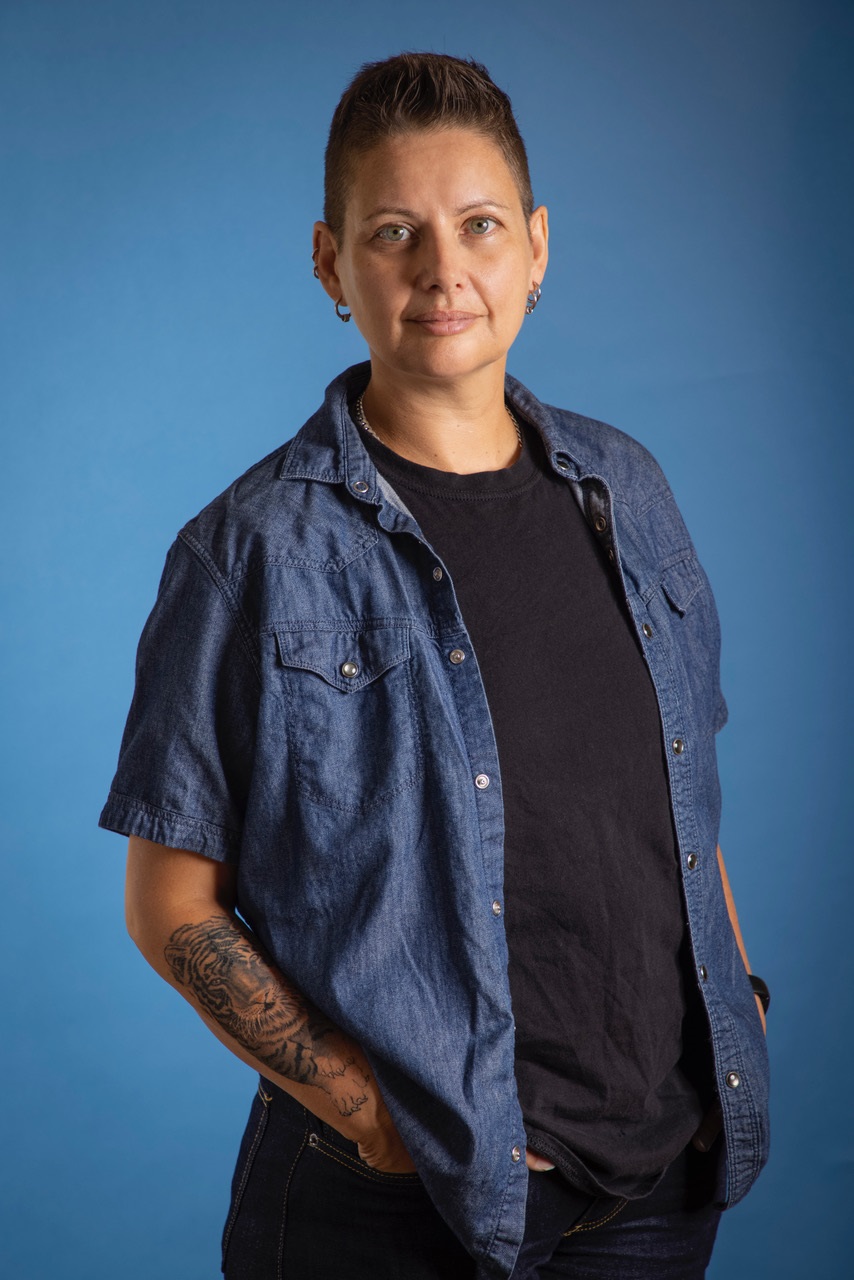 |
|
| photo: Lori Eanes | |
A writer of Uruguayan origins, Caro De Robertis is the author of The Palace of Eros (Primero Sueño Press/Atria), a retelling of the traditional Greek myth of Psyche and Eros through a queer and feminist lens, and five previous novels. Their books have been translated into 17 languages and have received numerous honors, including two Stonewall Book Awards, Italy's Rhegium Julii Prize, and the John Dos Passos Prize for Literature, which they were the first openly nonbinary writer to receive. De Robertis is also an award-winning literary translator and a professor at San Francisco State University. They are currently at work on a nonfiction book, So Many Stars: an Oral History of Trans, Nonbinary, Genderqueer, and Two-Spirit People of Color. They live in Oakland, Calif., with their two children.
Handsell readers your book in 25 words or less:
It's a retelling of the ancient Greek myth of Psyche and Eros that recasts Eros, god of desire, as a genderqueer nonbinary lesbian goddess.
On your nightstand now:
Once, my kids counted the books on my nightstand: 58. Currently, the tower is topped by a book I'm excited to dive into, Pink Slime by Fernanda Trías, and a gorgeous novel that recently stole my soul, Alex Espinoza's The Sons of El Rey.
Favorite book when you were a child:
When I was nine, I found Little Women by Louisa May Alcott--or it found me. Looking back, I see it as my first experience with a genuinely feminist text, which can be like water for a thirsty soul. Jo not only wants to be wild and free, but also a writer! When I was 10, and we immigrated to the U.S., my copy of Little Women was one of the treasures I brought with me. I lived in that book, and it helped me live in turn.
Your top five authors:
This hurts! Only five? To focus it down, here are a few contemporary writers whose work is inspiring me today: Angie Cruz, Jaquira Díaz, Julián Delgado Lopera, Louise Erdrich, and Jacqueline Woodson.
Book you've faked reading:
I won't admit it. I've mended my ways, I'm not that person anymore.
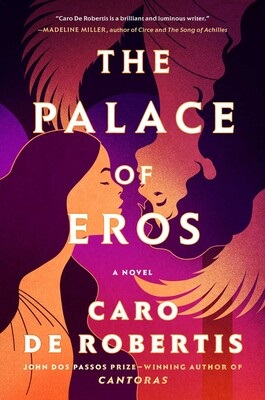 Book you're an evangelist for:
Book you're an evangelist for:
Bad Girls by Camila Sosa Villada. This utterly brilliant novel about trans women who live, love, do sex work, make community, and survive against the odds has been transforming the literary landscape in the author's native Argentina, and should be doing the same here in the U.S. The vision, the majestic sentences, the heart and grit, the wildly original approach, the raw honesty and tenderness--there's so much to say about how we need this book.
Book you've bought for the cover:
I don't think I've ever done this. But a cover I've recently adored is that of Justinian Huang's riveting debut novel, The Emperor and the Endless Palace. Its rich, color-saturated design reflects the queer, supremely erotic, riotously entertaining mythological romp within its pages--and had people stopping me in the airport to ask me about the book in my hands.
Book you hid from your parents:
Hear me out: The Unbearable Lightness of Being by Milan Kundera. At 13, I pulled it off the shelf and just started reading. Soon enough I'd hit sexual passages that stretched my rather sheltered imagination. That naked woman, on all fours in a bowler hat, did things to my queer-but-doesn't-know-it-yet mind that I could not yet articulate. I hid it from my parents even though the copy actually belonged to them.
Book that changed your life:
So very, very many. But to pick one: Loving in the War Years by Cherríe Moraga was the first book by a Latina lesbian I ever read. I was 19. My world exploded open. Suddenly there was more room for me to exist. For those of us whose truths are not sufficiently reflected in dominant society, finding books that speak to our experience with art and power can not only change our lives, but make our lives feel more possible. It's the most fabulous thing.
Favorite line from a book:
One current favorite is the last sentence of Jordy Rosenberg's trailblazing, transcendent, exquisitely written Confessions of the Fox. That novel would surely be a thrilling joy ride for anybody with a heart, but for queer and trans folks its subtext holds a hidden road map to inner freedom and belonging that is so beautiful to me, it's almost blinding, like the sun. I can't quote the sentence here, though. Its power has to be experienced by reading the whole book.
Five books you'll never part with:
I'd part with none! Why would you make me? But I suppose if I were forced to reach for only five in a fire, I might grab Toni Morrison's Beloved, Audre Lorde's Zami: A New Spelling of My Name, Qiu Miaojin's Notes of a Crocodile, the Eknath Easwaran translation of The Bhagavad Gita, Gabriel García Márquez's One Hundred Years of Solitude, Leslie Feinberg's Stone Butch Blues... Oh wait, I'm cheating...
Book you most want to read again for the first time:
I love rereading, the way each cycle through a book can sink you deeper. So, to be honest, I feel like I can always return to that experience with the books I connect to most--which is such a gift.
Book Candy
Book Candy
Open Culture featured Jack Kerouac's hand-drawn cover for On the Road (1952).
---
Dorkmunder and Ninnyhammer, for example. Mental Floss shared "20 old words for ignorant people."
---
The New York Public Library recommended "10 recently released and upcoming book-to-film adaptations not to miss."
Rediscover
Rediscover: Hettie Jones
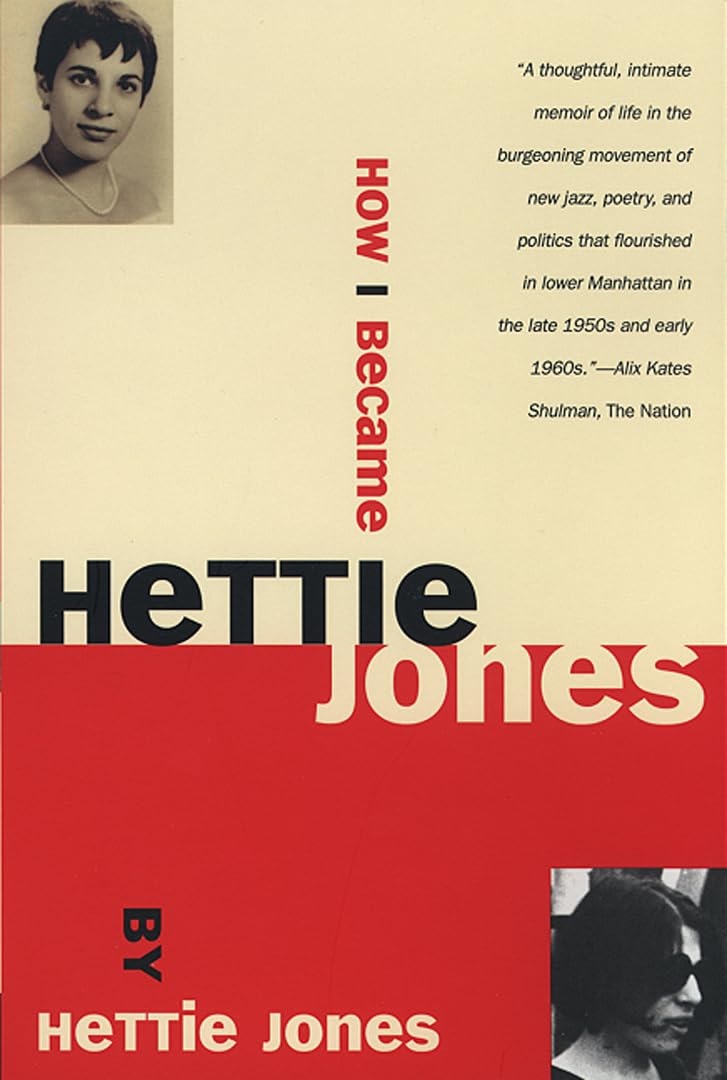 Poet and author Hettie Jones, who with her husband, LeRoi Jones (who later became the poet and playwright Amiri Baraka), "made her household a hub for Beat writers and other artists--but who was often described as a footnote in the rise of her famous spouse as 'the white wife' he disavowed,' " died August 13 at age 90, the New York Times reported. The author of 20 books, many of them works for children and young adults that focused on Black and Native American themes, her works include Big Star Fallin' Mama: Five Women in Black Music (1974); poetry collections Drive (1997), All Told (2003), and Doing 70 (2007). She also co-authored No Woman No Cry: My Life with Bob Marley, a memoir of Rita Marley, widow of Bob Marley.
Poet and author Hettie Jones, who with her husband, LeRoi Jones (who later became the poet and playwright Amiri Baraka), "made her household a hub for Beat writers and other artists--but who was often described as a footnote in the rise of her famous spouse as 'the white wife' he disavowed,' " died August 13 at age 90, the New York Times reported. The author of 20 books, many of them works for children and young adults that focused on Black and Native American themes, her works include Big Star Fallin' Mama: Five Women in Black Music (1974); poetry collections Drive (1997), All Told (2003), and Doing 70 (2007). She also co-authored No Woman No Cry: My Life with Bob Marley, a memoir of Rita Marley, widow of Bob Marley.
After dropping out of graduate school at Columbia University to work at the Record Changer, a jazz magazine, she met the young poet LeRoi Jones and they fell in love. In 1958, they started a literary magazine called Yūgen--a Japanese word that, the table of contents noted, translated to "elegance, beauty, grace, transcendence of these things, and also nothing at all." Beat heroes like Allen Ginsberg, Gregory Corso, Diane di Prima, and Jack Kerouac were among the contributors, along with Frank O'Hara and Robert Creeley.
They also launched Totem Press to publish books of poetry by new writers when they were both 23. In her 1990 memoir, How I Became Hettie Jones, she wrote: "I thought there'd be no stopping us." Their apartment was a hub and sanctuary for artist friends, who often stayed with them for months at a time or gathered to help put together issues of the magazine.
In the early 1960s, however, as LeRoi Jones's fame increased and as his affairs multiplied, the marriage suffered. "He was also undergoing an ideological transition, caught up in the Black nationalist movement and its often harsh identity politics," the Times wrote. "A few months after Malcolm X was assassinated in 1965, he left Ms. Jones and their two young daughters for Harlem; he later moved to Newark, where he became Amiri Baraka, married the Black poet Sylvia Robinson and disavowed his former life."
"Hettie and LeRoi seemed to be so perfectly attuned to one another," said author Joyce Johnson, whose memoir Minor Characters (1983) includes a scene in which she and Hettie Jones came of age. "Another woman would have been bitter, but she came to an understanding of why he left. She was remarkable. The last time we spoke about it, Hettie said, 'Well, it was a necessary consolidation of identity.' She was referring not only to LeRoi's abandonment of her, but of the integrated arts scene they had been a part of, which had looked so hopeful for a time."
"Her default setting was joy," Lisa Jones Brown, her daughter, said. "She was the patron saint of lost children of all persuasions. Our favorite nickname for her was 'Mother of the Masses.' "
Hettie Jones worked as an editor at Partisan Review, and later for a several publishers. She taught writing at New York University, the New School, Hunter College, and other institutions; and ran a writing workshop at the New York State Correctional Facility for Women at Bedford Hills.
"Her poems are playful," the poet Bob Holman, founder of the Bowery Poetry Club, said in an interview. "She's not afraid of rhyme, she's not afraid of direct address--for Hettie, poetry was just another way of talking to people." How I Became Hettie Jones is available from Grove Press.
| Advertisement Meet belle bear! |



